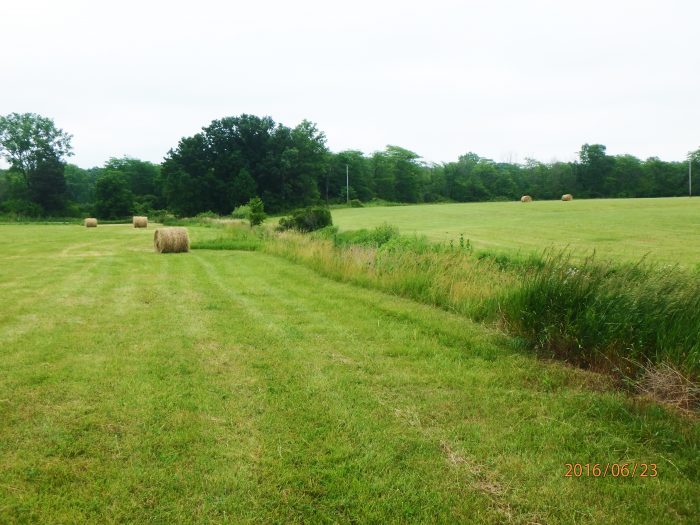Maumee Watershed Nutrient Reduction and Habitat Improvement Project

Pre-restoration ditched stream and hay fields to be restored by this project at the Forrest Woods Nature Preserve in Paulding County.
EnviroScience, Inc. and RiverReach Construction are proud to announce the kick off of the Forrest Woods Nature Preserve Restoration Project in Paulding County, Ohio. This design-build stream and wetland restoration project is being undertaken on behalf of the Black Swamp Conservancy (the “Conservancy”), who owns and manages the Forrest Woods Nature Preserve (the “Preserve”). The Preserve is one of the best remaining examples of the historic Great Black Swamp habitat, which used to be ubiquitous throughout the area. The project will restore two properties on the Preserve’s periphery that have been impacted by agricultural activities, including the ditching of stream and draining of wetlands using agricultural field tile.
In all, EnviroScience will restore over 3,600 L.F. of stream corridor and 40 acres of wetland habitat to the site. Over 50 acres of native vegetation will be planted after the completion of construction activities with a focus on riparian corridors, pockets of wooded wetlands, and micro-topographic ridges, which will be designed to replicate the Great Black Swamp habitat and morphology to the greatest possible degree.
In addition to the important stream, wetland, and riparian restoration goals, another critical aspect of this design-build project is the focus on incorporating nutrient reduction measures into the restoration design. This project will provide hard data to help determine whether stream and wetland restoration will be a viable mechanism in the effort to reduce Maumee River and Western Lake Erie nutrient loading and the resulting algae outbreaks and anoxic conditions.
One example of a nutrient reduction restoration feature that will be incorporated into the project are “denitrification riffle sequences”, which are extra deep, fine-grained riffle sequences designed to increase hyporheic zone flow and which are also seeded with woody material in order to speed the natural denitrification process. This incorporated woody material is critical until the riparian zone trees mature and can contribute large quantities of carbon naturally to the system. In addition to its denitrification benefits, maximizing the use of woody materials in this region is a much more holistic and cost-effective approach to restoration than using an unnatural and unnecessarily large volumes of rock.
EnviroScience is particularly pleased to be partnering on this project with researchers from Kent State University, who will be leading the effort to monitor and quantify the nutrient reduction benefits of the project. They will accomplish this through pre and post restoration water quality monitoring, nutrient analyses of site soils, and hydrologic assessments of the restoration sites. It is our hope that this project will help to better understand the biogeochemical processes that occur in restored stream, floodplain, and wetland ecosystems, which will lead to more comprehensive evaluation, and ultimately improvement, of restoration strategies aimed at nutrient reduction.
EnviroScience, RiverReach Construction and the whole project team would like to thank not only the Black Swamp Conservancy, but also the grant programs that provided the funding to make this project possible. These include the Great Lakes Restoration Initiative, the Ohio EPA Surface Water Improvement Fund (SWIF), and the National Fish and Wildlife Foundation’s Sustain Our Great Lakes Program.
We look forward to providing periodic updates on the restoration progress as well as the long-term nutrient reduction and aquatic habitat benefits of this project.